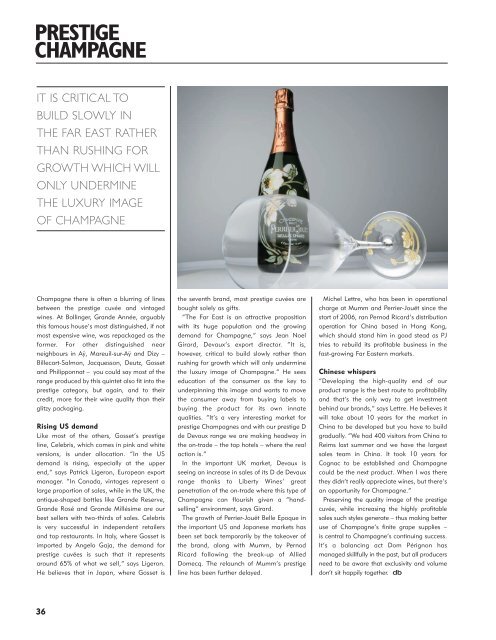Create successful ePaper yourself
Turn your PDF publications into a flip-book with our unique Google optimized e-Paper software.
PRESTIGE<br />
CHAMPAGNE<br />
IT IS CRITICAL TO<br />
BUILD SLOWLY IN<br />
THE FAR EAST RATHER<br />
THAN RUSHING FOR<br />
GROWTH WHICH WILL<br />
ONLY UNDERMINE<br />
THE LUXURY IMAGE<br />
OF CHAMPAGNE<br />
<strong>Champagne</strong> there is often a blurring of lines<br />
between the <strong>prestige</strong> cuvée and vintaged<br />
wines. At Bollinger, Grande Année, arguably<br />
this famous house’s most distinguished, if not<br />
most expensive wine, was repackaged as the<br />
former. For other distinguished near<br />
neighbours in Aÿ, Mareuil-sur-Aÿ and Dizy –<br />
Billecart-Salmon, Jacquesson, Deutz, Gosset<br />
and Philipponnat – you could say most of the<br />
range produced by this quintet also fit into the<br />
<strong>prestige</strong> category, but again, and to their<br />
credit, more for their wine quality than their<br />
glitzy packaging.<br />
Rising US demand<br />
Like most of the others, Gosset’s <strong>prestige</strong><br />
line, Celebris, which comes in pink and white<br />
versions, is under allocation. “In the US<br />
demand is rising, especially at the upper<br />
end,” says Patrick Ligeron, European export<br />
manager. “In Canada, vintages represent a<br />
large proportion of sales, while in the UK, the<br />
antique-shaped bottles like Grande Reserve,<br />
Grande Rosé and Grande Millésime are our<br />
best sellers with two-thirds of sales. Celebris<br />
is very successful in independent retailers<br />
and top restaurants. In Italy, where Gosset is<br />
imported by Angelo Gaja, the demand for<br />
<strong>prestige</strong> cuvées is such that it represents<br />
around 65% of what we sell,” says Ligeron.<br />
He believes that in Japan, where Gosset is<br />
36<br />
the seventh brand, most <strong>prestige</strong> cuvées are<br />
bought solely as gifts.<br />
“The Far East is an attractive proposition<br />
with its huge population and the growing<br />
demand for <strong>Champagne</strong>,” says Jean Noel<br />
Girard, Devaux’s export director. “It is,<br />
however, critical to build slowly rather than<br />
rushing for growth which will only undermine<br />
the luxury image of <strong>Champagne</strong>.” He sees<br />
education of the consumer as the key to<br />
underpinning this image and wants to move<br />
the consumer away from buying labels to<br />
buying the product for its own innate<br />
qualities. “It’s a very interesting market for<br />
<strong>prestige</strong> <strong>Champagne</strong>s and with our <strong>prestige</strong> D<br />
de Devaux range we are making headway in<br />
the on-trade – the top hotels – where the real<br />
action is.”<br />
In the important UK market, Devaux is<br />
seeing an increase in sales of its D de Devaux<br />
range thanks to Liberty Wines’ great<br />
penetration of the on-trade where this type of<br />
<strong>Champagne</strong> can flourish given a “handselling”<br />
environment, says Girard.<br />
The growth of Perrier-Jouët Belle Epoque in<br />
the important US and Japanese markets has<br />
been set back temporarily by the takeover of<br />
the brand, along with Mumm, by Pernod<br />
Ricard following the break-up of Allied<br />
Domecq. The relaunch of Mumm’s <strong>prestige</strong><br />
line has been further delayed.<br />
Michel Lettre, who has been in operational<br />
charge at Mumm and Perrier-Jouët since the<br />
start of 2006, ran Pernod Ricard’s distribution<br />
operation for China based in Hong Kong,<br />
which should stand him in good stead as PJ<br />
tries to rebuild its profitable business in the<br />
fast-growing Far Eastern markets.<br />
Chinese whispers<br />
“Developing the high-quality end of our<br />
product range is the best route to profitability<br />
and that’s the only way to get investment<br />
behind our brands,” says Lettre. He believes it<br />
will take about 10 years for the market in<br />
China to be developed but you have to build<br />
gradually. “We had 400 visitors from China to<br />
Reims last summer and we have the largest<br />
sales team in China. It took 10 years for<br />
Cognac to be established and <strong>Champagne</strong><br />
could be the next product. When I was there<br />
they didn’t really appreciate wines, but there’s<br />
an opportunity for <strong>Champagne</strong>.”<br />
Preserving the quality image of the <strong>prestige</strong><br />
cuvée, while increasing the highly profitable<br />
sales such styles generate – thus making better<br />
use of <strong>Champagne</strong>’s finite grape supplies –<br />
is central to <strong>Champagne</strong>’s continuing success.<br />
It’s a balancing act Dom Pérignon has<br />
managed skillfully in the past, but all producers<br />
need to be aware that exclusivity and volume<br />
don’t sit happily together. db


